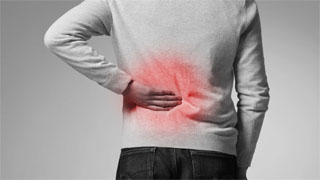
The stability of the lumbar spine is maintained by two interrelated systems, namely the spine itself and the muscle system associated with it. The former is a passive stabilizing system, while the latter is an active stabilizing system. Pathological changes in either system may cause lumbar instability. Due to the fact that this type of lumbar instability is a secondary and degenerative disease, it is common for clinical patients to experience weakness in the lumbar extensor muscles.
Imbalance of lower back muscle strength leads to biomechanical imbalance of the lower back, resulting in lower back pain.
Training the core muscle group can increase the stability, balance, and coordination of the patient's lumbar spine, thereby reducing the incidence and recurrence rate of chronic back pain.
Core muscle group: The so-called core muscle group refers to the important muscle groups located around the body in the front and back of the abdomen, responsible for protecting the stability of the spine, including the transverse abdominal muscles, pelvic floor muscles, and lower back muscles.
Simply put, it refers to the waist and back muscles in the trunk area.
The purpose of exercise therapy is to enhance the strength of the core muscles in the lower back and provide dynamic stability for degenerated intervertebral joints.
Lumbar core muscle training
Reasons for relieving lower back pain:
The direction of intervertebral joint movement during lumbar extension is opposite to the direction of lumbar flexion in daily life, avoiding the tensile strain on the extensor muscles and lumbar ligaments caused by lumbar flexion movement;
Stretching exercises and stretching muscles in the lower back can maintain a straight posture, reduce pressure within the intervertebral discs, and minimize further damage to the intervertebral discs;
Back and waist exercises improve blood circulation in the lower back, allowing for faster clearance of accumulated inflammatory and painful substances, thereby effectively relieving pain.
Simple exercise methods
01 "Arch Bridge Style" Sports
Lying in a supine position, with both knees flexed and bent while lifting the waist and hips upwards, keeping 5-10 centimeters off the bed and returning to the original position. Request 10 seconds, 10 on each side.
2. "Flying Swallows and Water" Movement
Prone position, with hands behind your back, lifting your limbs and chest simultaneously, leaving the bed surface, and returning to the original position. Request to hold for 10 seconds, do 10.
3 "Side Bridge" Movement
Using the forearm on the same side and the outer side of the foot as a fulcrum to support the body and maintain its integrity is relatively difficult. Request 10 seconds, 10 on each side.
4 "Flat Support" Movement
Align your body in a straight line, use your toes and forearms for support, contract your abdominal muscles for 10 seconds, then relax, and be careful not to hold your breath throughout the entire process. Request 10 seconds, 10 pieces.
5 "Cross Support" Movement
This action involves using the hands and feet on the opposite side as support, starting from a kneeling position with elbows and knees as support, extending one hand and the other foot, and maintaining a horizontal position. This position requires the body to be level and looking ahead. Hold on for 10 seconds, do 10.
The above actions are one set, at least three sets in total, with the intensity based on sweating without being too tired. You can do them two or three times a day as long as you are not too tired.


